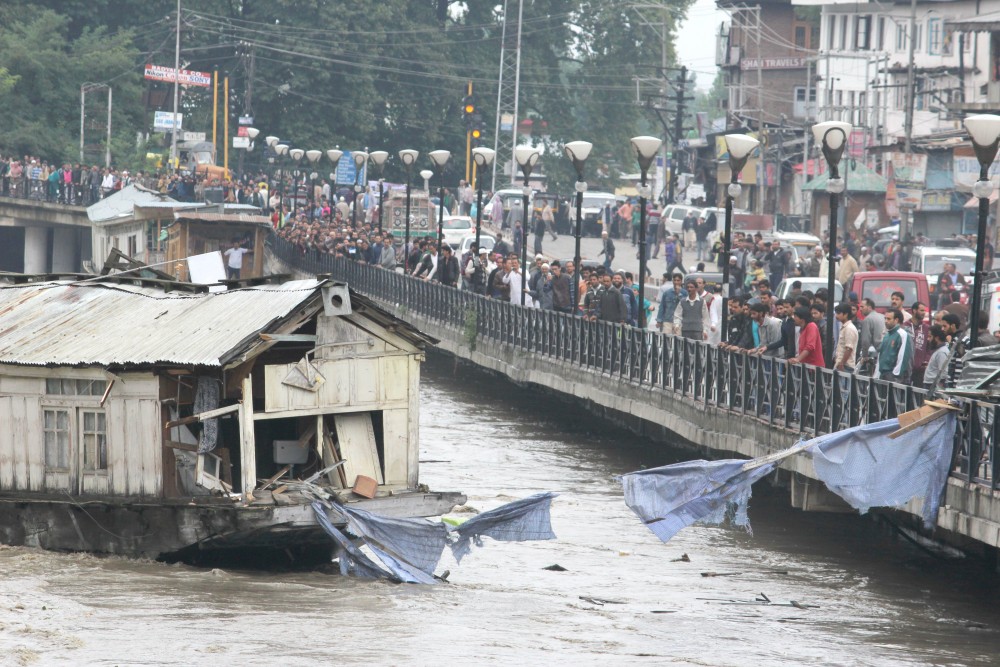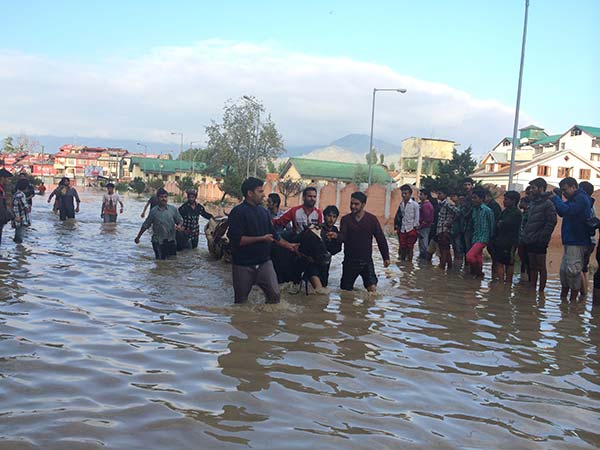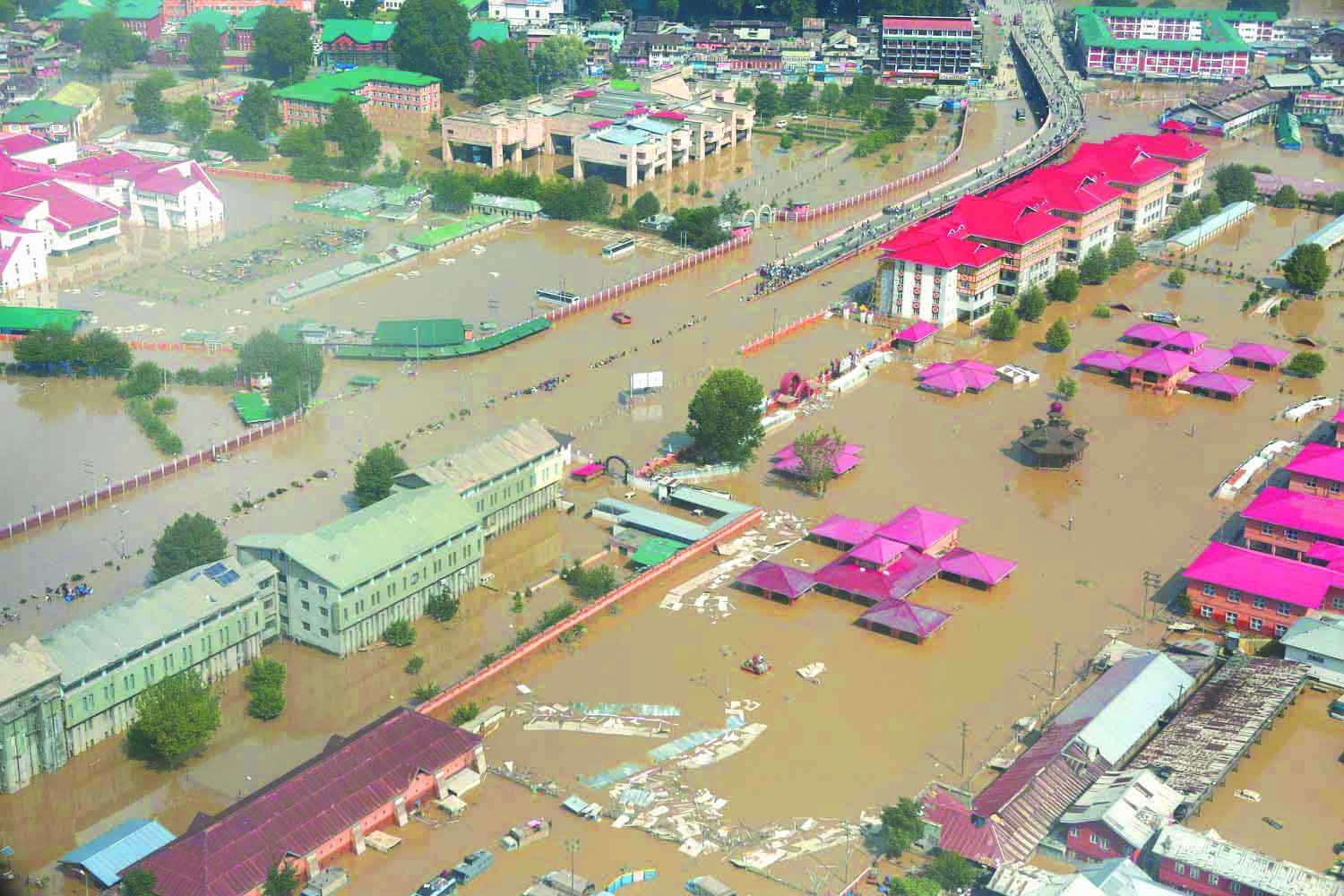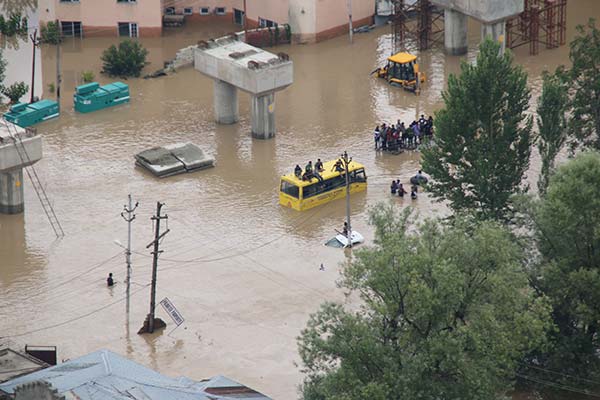by Athar Parvaiz

It has been over a month since a massive flood left the central and southern areas of Kashmir devastated killing 281 people and rendering thousands of families homeless besides damaging property worth one trillion rupees as per the official estimates.
And now, not surprisingly, questions about disaster preparedness and management are being asked. What made this disaster so bad? Could it have been averted? Could its impact have been minimized? Was there enough preparedness for the disaster? And why was the response so lousy and weak?
Government Clueless
With questions growing over governmental apathy, environmental negligence and flaws in reading the warning signs, officials say they are still clueless about the why and how of the worst floods in Kashmir valley’s recorded history.
“We are still not able to analyze what happened on September 7,” Pawan Kotwal the Commissioner Secretary for Flood Control said during a recent press conference. His department, Kotwal said, would study satellite images besides requesting New Delhi’s assistance for analyzing the disaster.
What the officials like Kotwal fail to answer is the misinterpretation or no interpretation of the data which was available with the meteorological department.

“There was a record 400mm precipitation in just four days which meant a huge disaster was in the making considering Kashmir’s topography, the limited carrying capacity of River Jhelum and its spill-over channel besides Kashmir’s proneness to flooding disasters. It is surprising why it did not serve as a warning,” Prof Bashir Ahmad, who teaches Geography in S P College, told Kashmir Life.
Even the flood control officials were constantly saying that the discharge in the river had created a new record with the water flowing more than 14 feet above the danger mark at Sangam in south Kashmir. Many say that it should have been quite easy for the flood control department to interpret. If they knew the carrying capacity of the River; why didn’t they do the simple arithmetic whether it commiserated with the carrying capacity downstream?
“It was not a flash flood where you have no breathing time; this was a disaster which was slowly building up and, therefore, an eye-opener. The bright spark was always there as the water kept rising above the danger mark. But, unfortunately, the officials failed to give clear and analytical warnings based on the available data,” Prof Bashir observed.
When you give simple warnings [like the water is rising above the danger mark], it hardly leaves an impact; more so in our society. But, if the people, based on a scientific and technical interpretation of the information and facts, were told in no uncertain terms that the banks of the Jhelum will breach at many places given the amount of surplus water and the water will inundate most of the city areas covering one and a half story of the houses, common people and thousands of shopkeepers would have definitely paid heed and might have even saved their property by shifting it to safer places.
For the central government in New Delhi, a series of disasters in recent years should have thrown up some important lessons. That is why it is blamed for not doing enough for effective disaster preparedness and improving disaster management though, on paper, the country’s disaster management system and preparedness has hardly any loopholes
The 10 Percent Syndrome
Requesting anonymity, a top official of the National Disaster Management Authority (NDMA) said that only 10 per cent is done or implemented from what is written on official documents or discussed during meetings regarding disaster preparedness and management.
The result: Replay of faulty execution of disaster management operations and ill-preparedness for disasters of the magnitude, which recently struck Jammu and Kashmir and the north-eastern state of Meghalaya, often invite criticism from sections ranging from disaster victims to observers and analysts.
While speaking on the foundation day of National Disaster Management Authority (NDMA) on September 29, the union junior home minister, Kiren Rijiju blamed the state governments in Jammu and Kashmir and Meghalaya saying the way they managed the September disasters was “not up to the mark.”
He emphasized that India will have to play a bigger role in disaster management, at least in South Asia. But, for India to do that there has to be an effective mechanism in place in all the parts of this country often called the sub-continent.

According to a paper by the researchers of IIT Kanpur, India has been traditionally vulnerable to natural disasters on account of its unique geo-climatic conditions. Floods, droughts, cyclones, earthquakes, and landslides have been a recurrent phenomenon. About 60 per cent of the landmass is prone to earthquakes of various intensities; over 40 million hectares is prone to floods. The paper has listed a number of weaknesses and problem areas like inadequate early warning systems, inadequate and slow relief, slow rehabilitation and reconstruction, poor management of finances for disaster relief etc.
A number of states in India do not have their own disaster management authorities and the disaster management continues to be the additional charge of the principal secretaries revenue in all the states. “What can they do for disaster management when they already have enough tasks at hand from their own department,” the NDMA official said.
Lack of Coordination and Planning
The lack of coordination and cooperation between the states and the centre is another problem area. Talking with special reference to disaster response in Kashmir, the NDMA official says that the Jammu & Kashmir government did not respond to repeated requests from NDMA since 2011 for providing space for a National Disaster Response Force (NDRF) team in Kashmir.
The preparedness of Jammu and Kashmir’s own disaster response force got exposed when they could not appear on the scene following the disaster for days together. When Kashmir Life asked a top official of State Disaster Response Force (SDRF) why it took more than a week for his troops to appear for the rescue and relief operations, he made no bones to express his helplessness. “What could we do with empty hands? We didn’t have the required wherewithal like boats or safety jackets for rescue operations,” he said.
According to insiders in SDRF, the “special force” was given 90 million rupees only after the disaster. No basic tools like boats, jackets, landslide clearance JCBs etc. for fighting the disasters have been procured for SDRF founded in 2012.
Flood control Programme
The state government led by Omar Abdullah has been playing the classic blame game. Its claim that the Central Water Commission (CWC) in New Delhi rejected a ‘well thought out plan’ for flood control in Kashmir for lack of minute details has been a standard response from the chief minister to other government officials.
Over the past several weeks, the Jammu and Kashmir government keeps maintaining that the September 7 destructive flood could have been averted if the state government’s INR 2200 crore flood control programme in 2010 was accepted by the central government in New Delhi.
Mir Javid Jaffer, the chief engineer for flood control says that the project was aimed at raising the carrying capacity of River Jhelum and the spill-over flood channel from the current 50,000 cusecs to 120,000 cusecs and the dredging of outfall channels downstream.
The Jammu and Kashmir government and its flood control department are right in saying that this disaster wouldn’t have been a possibility or the damage could have been much lesser if its flood control project was accepted. But, it has no idea why the central water commission (CWC) would accept its project which lacked technical details.
“We had no objection to what the Jammu and Kashmir government was apprehending, but they only submitted a tentative project based on mere assumptions and failed to support their project with the technical details,” Chander Pal Singh, chief engineer flood management at CWC New Delhi told Kashmir Life over the phone.

“If its flood control department had not the required human resource to support the project with technical details, it could have outsourced the project to some agency,” he said adding it would have cost them somewhere around half a million rupees. “We waited for months together for these details which they failed to provide,” Singh said that CWC is still ready to support them, but they still need to submit a technically correct project. “The recent disaster can, of course, help them.”
Mir and the chief minister Omar Abdullah say that the disaster has proved them right. “Fortunately, the disaster has now proved it practically. Now there is a practical proof and we don’t need to prove it anymore,” Abdullah has been saying repeatedly after the disaster. Had they been able to convince CWC for granting the required amount in time, their assertions would have been much more different in phraseology and meaningfulness?
Massive Encroachments
During the past three decades, water bodies in Srinagar city which include River Jhelum, its spill-over channel and various water bodies have been encroached upon with some built-up areas extending right inside these water bodies.
Many of the flooded areas in recent floods include some areas which are actually the extension areas of wetlands which had served as water sinks during the huge flooding of Srinagar city in 1902. In fact, the office of Srinagar Development Authority (SDA), off-shoot of SKIMS hospital and many other important government buildings have been constructed in Bemina just adjacent to the flood spill-over channel and a wetland. And a few more are coming up in the same area.
As people watched in awe the flooding of the city in the past few weeks, some old men vividly recalled the days when they used to fish in some areas of the city which are now replaced by posh residential colonies. “People used to throng this area for fishing when I was a young boy,” Muzaffar Mir, an elderly man said about Bemina, a sprawling residential area in Srinagar which used to be a wetland.
Even the banks of River Jhelum, which is regarded by many as the sleeping tiger, was not spared. It was officially announced by chief minister Omar Abdullah after the September 7 floods that many influential politicians were involved in the encroachment of river banks of Jhelum in some areas of the city. Just imagine the impact of such statements if made in the nick of time and followed with the required action!
What is more concerning is the fact that many residential colonies have come up in the lower areas along the banks of spill-over flood channel which runs through the city.














